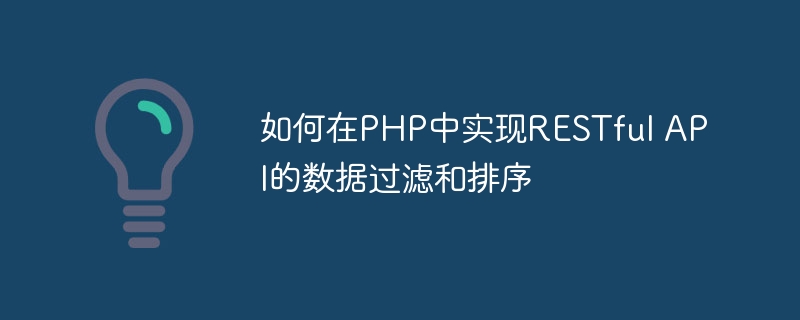Home >Backend Development >PHP Tutorial >How to implement data filtering and sorting for RESTful API in PHP
How to implement data filtering and sorting for RESTful API in PHP
- WBOYWBOYWBOYWBOYWBOYWBOYWBOYWBOYWBOYWBOYWBOYWBOYWBOriginal
- 2023-09-05 13:12:25813browse

How to implement data filtering and sorting of RESTful API in PHP
With the continuous development of web applications, RESTful API has become a commonly used data in modern applications One of the ways of interaction. In the REST architecture, the design and implementation of APIs need to take into account the filtering and sorting of data in order to return data that meets user needs. This article will introduce how to implement the data filtering and sorting functions of RESTful API in PHP, with code examples.
1. Data filtering
In the RESTful API, data filtering refers to selecting data that meets specific conditions from the database or other data sources according to the user's needs. Common data filtering methods include field-based filtering, logical operator filtering, and fuzzy query. The following is a sample code that demonstrates how to implement field-based data filtering in PHP:
<?php
// 获取用户请求的过滤条件
$filters = $_GET['filters'];
// 连接数据库
$conn = new mysqli("localhost", "username", "password", "database");
// 构建SQL查询语句
$sql = "SELECT * FROM users WHERE 1=1";
foreach ($filters as $key => $value) {
$sql .= " AND $key = '$value'";
}
// 执行查询
$result = $conn->query($sql);
// 处理查询结果
if ($result->num_rows > 0) {
while ($row = $result->fetch_assoc()) {
// 处理每一行数据
echo "User ID: " . $row['id'] . "<br>";
echo "Name: " . $row['name'] . "<br>";
echo "Email: " . $row['email'] . "<br>";
}
} else {
echo "No results found.";
}
// 关闭数据库连接
$conn->close();
?> In the above code, the filter conditions are first obtained based on the filters parameters in the user request. Then the filter conditions are spliced into SQL query statements through loops, and finally the query is executed and the results are output.
2. Data sorting
In the RESTful API, data sorting means arranging the queried data in ascending or descending order according to the specified fields according to the user's needs. The following is a sample code that demonstrates how to implement the data sorting function in PHP:
<?php
// 获取用户请求的排序条件
$order = $_GET['order'];
// 连接数据库
$conn = new mysqli("localhost", "username", "password", "database");
// 构建SQL查询语句
$sql = "SELECT * FROM users ORDER BY $order ASC";
// 执行查询
$result = $conn->query($sql);
// 处理查询结果
if ($result->num_rows > 0) {
while ($row = $result->fetch_assoc()) {
// 处理每一行数据
echo "User ID: " . $row['id'] . "<br>";
echo "Name: " . $row['name'] . "<br>";
echo "Email: " . $row['email'] . "<br>";
}
} else {
echo "No results found.";
}
// 关闭数据库连接
$conn->close();
?> In the above code, the sorting conditions are first obtained based on the order parameter in the user request. Then splice the sorting conditions into the SQL query statement, and sort in ascending order through the ASC keyword. If you need to sort in descending order, you can change ASC to DESC.
Summary
Implementing the data filtering and sorting functions of RESTful API in PHP is a problem that developers often face. Through the introduction and sample code of this article, you can learn how to use PHP language to implement data filtering and sorting functions according to user needs. These tips can help you design and implement more flexible and efficient RESTful API interfaces.
The above is the detailed content of How to implement data filtering and sorting for RESTful API in PHP. For more information, please follow other related articles on the PHP Chinese website!

